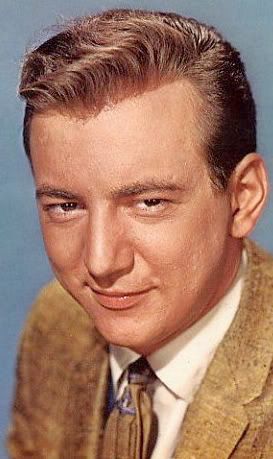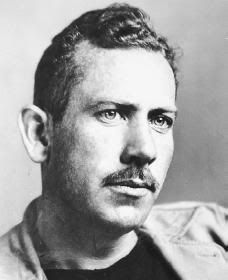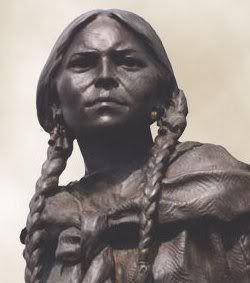Monday, December 20, 2010
"Beyond The Sea" by Bobby Darin
Midcentury masculine grace had no better paragon than Bobby Darin; such a straightforward delivery, and what poise! That Robbie Williams could learn a thing or two from this guy*...
Here he is, singing just one of his classics: Beyond the Sea. The lyrics are pop elegance itself, as sleek and simple as his delivery of them - in all, the ideal blend of singer and song.
*And probably has!
*
The Late, Great Bobby Darin
From an early age, Bobby Darin knew his days were numbered...
 Raised on Home Relief in The Bronx during the Great Depression, as a child he suffered from multiple bouts of rheumatic fever, which seriously weakened his heart; in fact, he wasn't supposed to live past the age of 16.
Raised on Home Relief in The Bronx during the Great Depression, as a child he suffered from multiple bouts of rheumatic fever, which seriously weakened his heart; in fact, he wasn't supposed to live past the age of 16.
Yet not only did he outlive his diagnosis by 20 years, he packed those years with hit records, movie roles, and nightclub appearances a-plenty. His is a story of the power of art in the life of an artist; self-medicated by his capacious creativity, he lived his career with a single-mindedness rare among young talent, especially these days. The charisma he oozed onstage, though, often belied the bellicose douchebaggery for which he became known in his private life.
For all that he must have been aware he was living on borrowed time, onstage Bobby Darin was a paragon of cool; he never could even play flustered successfully, let alone be it, though he often tried, to great comic effect.
Bobby Darin died on this day in 1973.
Bobby Darin has been memorably portrayed on film by Kevin Spacey, who mastered Darin's delivery so as to sing all his own songs, in the film Beyond The Sea (2004).
*
Yet not only did he outlive his diagnosis by 20 years, he packed those years with hit records, movie roles, and nightclub appearances a-plenty. His is a story of the power of art in the life of an artist; self-medicated by his capacious creativity, he lived his career with a single-mindedness rare among young talent, especially these days. The charisma he oozed onstage, though, often belied the bellicose douchebaggery for which he became known in his private life.
For all that he must have been aware he was living on borrowed time, onstage Bobby Darin was a paragon of cool; he never could even play flustered successfully, let alone be it, though he often tried, to great comic effect.
Bobby Darin died on this day in 1973.
Bobby Darin has been memorably portrayed on film by Kevin Spacey, who mastered Darin's delivery so as to sing all his own songs, in the film Beyond The Sea (2004).
*
Remembering... John Steinbeck
As far as reading is concerned, I guess you could call me pretty lucky; the novels I was 'forced' to read in school (as if I ever had to be forced to read, especially in school) are today some of my all-time favourites. Surprisingly, this was not the experience of most of my friends...
 Among the formidable works I assayed in Mrs. Horsfall's class - 1984, To Kill A Mockingbird, and The Tin Flute to name just three - one in particular stands even above these masterpieces in my recollection: John Steinbeck's Cannery Row (1945). As an exile from the West Coast in the cultural (not to mention meteorological) aridity of Saskatchewan I often found myself gasping for moisture; opening the front cover of Cannery Row for the first time, then, was akin to peeling a grapefruit in the shower.
Among the formidable works I assayed in Mrs. Horsfall's class - 1984, To Kill A Mockingbird, and The Tin Flute to name just three - one in particular stands even above these masterpieces in my recollection: John Steinbeck's Cannery Row (1945). As an exile from the West Coast in the cultural (not to mention meteorological) aridity of Saskatchewan I often found myself gasping for moisture; opening the front cover of Cannery Row for the first time, then, was akin to peeling a grapefruit in the shower.
It isn't a vast sweeping epic in the sense some of his works - The Grapes of Wrath (1939) or East of Eden (1952), for instance - are; it's a slice of life rich in characterization - not unlike Tortilla Flat (1935) or The Wayward Bus (1947) - yet even more sensitively rendered than they. Its sequel, Sweet Thursday (1947), finds the same characters the same number of years older as their author - some jaded, some embittered, some the same old happy-go-lucky - and provides a bittersweet bookend to its predecessor.
John Steinbeck's career, naturally, extended into the movies; Of Mice and Men (1939), The Grapes of Wrath (1940), Tortilla Flat (1942), The Red Pony (1949), East of Eden (1955), The Wayward Bus (1956), and Cannery Row (1982) were all adapted for the cinema before Of Mice and Men was remade in 1992. In addition, he wrote an original screenplay for Alfred Hitchcock entitled Lifeboat (1944).
Winner of the Pulitzer Prize for The Grapes of Wrath, in 1962 John Steinbeck was also awarded the Nobel Prize for Literature; plus, as the image shows, he was a handsome devil - which is surely the sweetest prize of them all. He died on this day in 1968.
*
It isn't a vast sweeping epic in the sense some of his works - The Grapes of Wrath (1939) or East of Eden (1952), for instance - are; it's a slice of life rich in characterization - not unlike Tortilla Flat (1935) or The Wayward Bus (1947) - yet even more sensitively rendered than they. Its sequel, Sweet Thursday (1947), finds the same characters the same number of years older as their author - some jaded, some embittered, some the same old happy-go-lucky - and provides a bittersweet bookend to its predecessor.
John Steinbeck's career, naturally, extended into the movies; Of Mice and Men (1939), The Grapes of Wrath (1940), Tortilla Flat (1942), The Red Pony (1949), East of Eden (1955), The Wayward Bus (1956), and Cannery Row (1982) were all adapted for the cinema before Of Mice and Men was remade in 1992. In addition, he wrote an original screenplay for Alfred Hitchcock entitled Lifeboat (1944).
Winner of the Pulitzer Prize for The Grapes of Wrath, in 1962 John Steinbeck was also awarded the Nobel Prize for Literature; plus, as the image shows, he was a handsome devil - which is surely the sweetest prize of them all. He died on this day in 1968.
*
"Don't Answer Me" by Alan Parsons Project
This is, hands down, one of the best videos of the Eighties; it rarely ever got shown on shows like Video Hits at the time, though, because they were too busy playing Duran Duran - seriously, how many times did they play The Reflex anyway? That Samantha Taylor's really got a lot to answer for... Anyway, I saw this clip once on Friday Night Videos more than twenty years ago, and never forgot it; seeing it again reminds me of the indelibility of art, and the responsibility that falls to the artist because of that.
From The Alan Parsons Project - and on the occasion of Mr. Alan Parsons' 62nd birthday - it's Don't Answer Me, from the 1984 album Ammonia Avenue.
*
The Death of Sacagawea?
The details of her short life are scarce, and the only proof we have that she might have died on this day in 1812 at the age of 25 is a vague entry in the log of a fur trader named Henry Brackenridge at the Fort Manuel Lisa Trading Post: '…the wife of Charbonneau . . . died of putrid fever.' Then again, the entry could have been referring to her husband's other wife, Otter Woman; or else she might have had enough of him calling her 'squaw', and her husband lied about her death to cover his shame at having been deserted by her.
 Either way, like Pocahontas - her forbear in the forbearance of white men - Sacagawea's contribution to the European conquest of her homeland has often been neglected, especially by those whom it benefited most. Yet as the only female member of Meriwether Lewis and William Clark's Corps of Discovery (serving as their translator, along with her husband, a French-Canadian trapper named Toussaint Charbonneau) the young Shoshone would prove time and again that she was the only woman for the job that only a woman could do; for a young woman with a baby to be traveling safely with a group of white men was to serve as a powerful emblem of their peaceful intentions to every tribe they encountered over the next two years.
Either way, like Pocahontas - her forbear in the forbearance of white men - Sacagawea's contribution to the European conquest of her homeland has often been neglected, especially by those whom it benefited most. Yet as the only female member of Meriwether Lewis and William Clark's Corps of Discovery (serving as their translator, along with her husband, a French-Canadian trapper named Toussaint Charbonneau) the young Shoshone would prove time and again that she was the only woman for the job that only a woman could do; for a young woman with a baby to be traveling safely with a group of white men was to serve as a powerful emblem of their peaceful intentions to every tribe they encountered over the next two years.
Joining the expedition at a Hidatsa village near the present-day Washburn, North Dakota, in November 1804, after giving birth (to Jean Baptiste Charbonneau) Sacagawea and her family moved into the temporary Fort Mandan; by April 1805 the group of explorers was ready to set out across the Rocky Mountains. In May of that year, after her quick reflexes saved the journals of Lewis and Clark from a potential watery grave, they named the Sacagawea River after her.
It was in August, though, that Sacagawea's presence would come in handiest; as the expedition neared the Columbia River, they found a tribe with whom they wished to trade. It turns out the chief of that tribe was Sacagawea's long-lost brother, Cameahwait, whom she hadn't seen since she was stolen from their village when she was 12 (circa 1800) and the trade was arranged. Reaching the Pacific Ocean in November 1805, the group wintered at Fort Clatsop, in Oregon.
On the return trip in 1806 Sacagawea suggested that they take a different route, and cross into the Yellowstone River basin at what is now known as Bozeman Pass; after subsequent exhaustive surveys of the entire cordilleran region, hers was the route chosen as the optimal one for the Northern Pacific Railway to cross the continental divide. Following the return of the expedition to where she and her family had first joined it, they remained there for three years, moving to St. Louis in 1809, and thence into the fort where she may have died in 1812.
Still, legends persist... The most persistent of these is that Sacagawea died at Wyoming's Wind River Indian Reservation in April 1884 at the age of 96, having changed her name from the Hidatsa name she is best known by to the Shoshone name Porivo (meaning chief woman); a monument to Porivo (aka Sacagawea) was erected at her graveside near Lander, Wyoming, in 1963.
Sacagawea lives on in two works of fiction: one written in 1933 by Grace Hebard, the other written in 1984 by Anna Lee Waldo; both are called Sacajawea.
*
Joining the expedition at a Hidatsa village near the present-day Washburn, North Dakota, in November 1804, after giving birth (to Jean Baptiste Charbonneau) Sacagawea and her family moved into the temporary Fort Mandan; by April 1805 the group of explorers was ready to set out across the Rocky Mountains. In May of that year, after her quick reflexes saved the journals of Lewis and Clark from a potential watery grave, they named the Sacagawea River after her.
It was in August, though, that Sacagawea's presence would come in handiest; as the expedition neared the Columbia River, they found a tribe with whom they wished to trade. It turns out the chief of that tribe was Sacagawea's long-lost brother, Cameahwait, whom she hadn't seen since she was stolen from their village when she was 12 (circa 1800) and the trade was arranged. Reaching the Pacific Ocean in November 1805, the group wintered at Fort Clatsop, in Oregon.
On the return trip in 1806 Sacagawea suggested that they take a different route, and cross into the Yellowstone River basin at what is now known as Bozeman Pass; after subsequent exhaustive surveys of the entire cordilleran region, hers was the route chosen as the optimal one for the Northern Pacific Railway to cross the continental divide. Following the return of the expedition to where she and her family had first joined it, they remained there for three years, moving to St. Louis in 1809, and thence into the fort where she may have died in 1812.
Still, legends persist... The most persistent of these is that Sacagawea died at Wyoming's Wind River Indian Reservation in April 1884 at the age of 96, having changed her name from the Hidatsa name she is best known by to the Shoshone name Porivo (meaning chief woman); a monument to Porivo (aka Sacagawea) was erected at her graveside near Lander, Wyoming, in 1963.
Sacagawea lives on in two works of fiction: one written in 1933 by Grace Hebard, the other written in 1984 by Anna Lee Waldo; both are called Sacajawea.
*
¡Feliz Cumpleaños! Infanta Elena, Duques de Lugo
Although the eldest child of Spain's King Juan Carlos I and Queen Sofía was briefly catapulted into the headlines around the world at the time, in the years since she's managed to maintain a far lower profile, while still keeping busy engaged in charity work and undergoing the usual royal round. If you'd like to know what she's been up to, and you can read Spanish, you might want to click here for a glimpse at her calendar of events.
*
Remembering... Irene Dunne
Born on this day in 1898, Irene Dunne was one of the most beloved film stars of the Thirties and Forties; her career began and ended in the theatre, and Hollywood was little more than a diversion for her. 'I drifted into acting and drifted out,' she once told an interviewer. 'Acting is not everything. Living is.'
 An early role in Cimarron (1931) - only her second movie - earned her the first of five Academy Award nominations (none of which she won); Dunne is often cited as the best actor to never win an Oscar, which puts her in company with Alfred Hitchcock, the best director who never won one either. She also distinguished herself in, among others: Back Street (1932), The Age of Innocence (1934), Roberta (1935), Show Boat (1936), My Favorite Wife (1940), Penny Serenade (1941), Anna and the King of Siam (1946), Life with Father (1947), and I Remember Mama (1948). Her last film role was It Grows on Trees (1952).
An early role in Cimarron (1931) - only her second movie - earned her the first of five Academy Award nominations (none of which she won); Dunne is often cited as the best actor to never win an Oscar, which puts her in company with Alfred Hitchcock, the best director who never won one either. She also distinguished herself in, among others: Back Street (1932), The Age of Innocence (1934), Roberta (1935), Show Boat (1936), My Favorite Wife (1940), Penny Serenade (1941), Anna and the King of Siam (1946), Life with Father (1947), and I Remember Mama (1948). Her last film role was It Grows on Trees (1952).
Most memorably, though, she appeared in The Awful Truth (1937) with Cary Grant and Ralph Bellamy, a film which has been screened more times than I can count at the Pop Culture Institute; this near-perfect frisson of passion and whimsy features the ideal element for romantic comedy which, alas, is too often missing from it - namely witty banter.
Dunne died in September 1990, at the age of 91.
*
Most memorably, though, she appeared in The Awful Truth (1937) with Cary Grant and Ralph Bellamy, a film which has been screened more times than I can count at the Pop Culture Institute; this near-perfect frisson of passion and whimsy features the ideal element for romantic comedy which, alas, is too often missing from it - namely witty banter.
Dunne died in September 1990, at the age of 91.
*